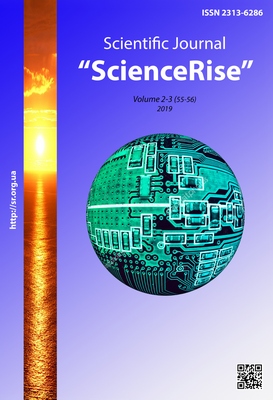Формалізація опису складових процесної моделі навчання
DOI:
https://doi.org/10.15587/2313-8416.2019.160052Ключові слова:
процесна модель навчання, критерій, ресурсна складова, рангова модель, холархічна модель, орієнтований графАнотація
В дослідженні проведено загальний аналіз складових процесної моделі навчання. Запропоновано орієнтований граф, вершинами якого є критерії якості ресурсної складової процесної моделі. Спроектовано рангова модель, яка дозволяє характеризувати критерії якості ресурсної складової. Розглянута процедура перетворення рангової моделі в відповідну їй холархічну модель. Особливу увагу приділено організації гранично спрощеному діалогу з експертом, що дозволяє суттєво розширити перелік викладачів-розробників процесних моделей навчання. Наукова новизна даного дослідження визначається розробленим на базі методу аналізу систем холархічної моделі кількісного упорядкування критеріїв якості ресурсної складової процесної моделі. Це дозволяє в умовах ресурсних обмежень (тимчасових або фінансових) зосередити основу увагу розробника процесної моделі навчання на найбільш важливіші критерії її якості
Посилання
Yakovlev, E. V., Yakovleva, N. O. (2016). Model' kak rezul'tat modelirovaniya pedagogicheskogo protsessa. Vestnik Chelyabinskogo gosudarstvennogo pedagogicheskogo universiteta, 9, 136–140.
Hiltz, S. R., Turoff, M. (2005). Education goes digital: The evolution of online learning and the revolution in higher educacion. Communications of the ACM, 48 (10), 59–64. doi: http://doi.org/10.1145/1089107.1089139
Goryachova, M. V. (2008). Modelirovanie pedagogicheskikh protsessov. Uspekhi sovremennogo estestvoznaniya, 1, 74–75.
Ishizaka, A., Nemery, P. (2013). Multi-Criteria Decision Analysis: Methods and Software. John Wiley & Sons, Ltd. Published. doi: http://doi.org/10.1002/9781118644898
Dias, L. C., Mousseau, V. (Eds.) (2014). Journal of Multi-Criteria Decision Analysis. Special Issue: “Applying MCDA: challenges and case studies”, 21 (1-2), 1–93.
Stulov, A. Otsenka effektivnosti elektronnogo distantsionnogo obucheniya. Spravochnik po upravleniyu personalom. Available at: http://eng.websoft.ru/db/wb/26D3C1E6AD7BC171442579820031F250/doc.html
Latypova, V. A. (2016). Otsenka effektivnosti protsessa obucheniya pri nalichii slozhnykh otkrytykh zadach s pomoshh'yu ekspertnykh metodov. Ufimskiy gosudarstvennyy aviatsionnyy tekhnicheskiy universitet. Inzhenernyy vestnik Dona, 1. Available at: https://cyberleninka.ru/article/v/otsenka-effektivnosti-protsessa-obucheniya-pri-nalichii-slozhnyh-otkrytyh-zadach-s-pomoschyu-ekspertnyh-metodov
Bilyk, O. O. (2009). Monitorynh yakosti zahalnoosvitnikh navchalnykh zakladiv. Cherkasy: ChDEU.
Bratkevych, V. V. (2016). Otsenka kachestva system podderzhky E-learning. Systemy obrobky informatsii. Problemy i perspektyvy rozvytku IT-industrii, 4 (141), 219–222.
Saaty, T. L. (1993). Pryniatye reshenyi. Metod analyza yerarkhyi. Moscow: Radyo y sviaz, 278.
Senkivskyi, V. M., Kozak, R. O. (2008). Avtomatyzovane proektuvannia knyzhkovykh vydan. Lviv: Ukrainska akademiia drukarstva, 200.
Thomas, L. S. Super Decisions CDF. Available at: https://www.superdecisions.com/models/
Saati, T. L. (2008). Prinyatie resheniy pri zavisimostyakh i obratnykh svyazyakh. Moscow: LKI, 360.
##submission.downloads##
Опубліковано
Номер
Розділ
Ліцензія
Авторське право (c) 2019 Vyacheslav Bratkevich

Ця робота ліцензується відповідно до Creative Commons Attribution 4.0 International License.
Наше видання використовує положення про авторські права Creative Commons CC BY для журналів відкритого доступу.
Автори, які публікуються у цьому журналі, погоджуються з наступними умовами:
1. Автори залишають за собою право на авторство своєї роботи та передають журналу право першої публікації цієї роботи на умовах ліцензії Creative Commons CC BY, котра дозволяє іншим особам вільно розповсюджувати опубліковану роботу з обов'язковим посиланням на авторів оригінальної роботи та першу публікацію роботи у цьому журналі.
2. Автори мають право укладати самостійні додаткові угоди щодо неексклюзивного розповсюдження роботи у тому вигляді, в якому вона була опублікована цим журналом (наприклад, розміщувати роботу в електронному сховищі установи або публікувати у складі монографії), за умови збереження посилання на першу публікацію роботи у цьому журналі.

